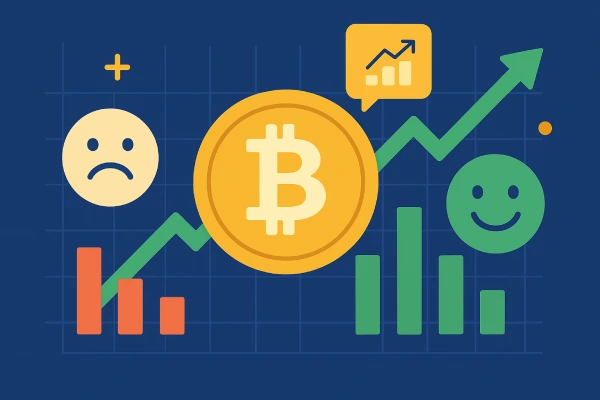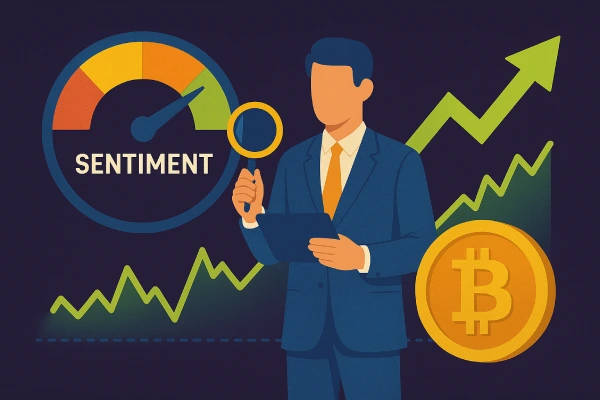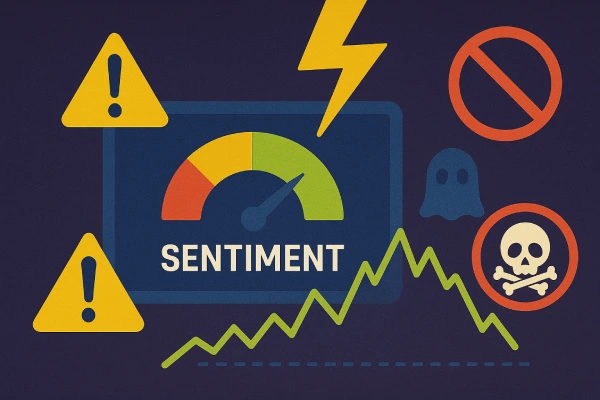How Market Sentiment Drives Price
How Market Sentiment Drives Price
"Discover how investor emotions like fear and greed influence cryptocurrency prices. Learn how market sentiment shapes price trends and how to use it in your crypto trading strategy."
Wikilix Team
Educational Content Team
15 min
Reading time
Intermediate
Difficulty

Market sentiment is collective investor emotion, which can encompass panic, fear, greed, exuberance, frivolity, and optimism. Market sentiment is key to how the cryptocurrency price functions in general. In a largely speculative environment, especially in the case of cryptocurrencies, Sentiment usually amplifies price movements far quicker and sharper than fundamentals or technicals can in either direction. Correctly understanding market sentiment can be the difference between reacting and making smart trading decisions.
What Is Market Sentiment in Crypto?
Market sentiment is the collective attitude of traders toward digital assets. Like in traditional financial markets, cryptocurrency's value is influenced by the Sentiment attached to the assets; however, unlike traditional markets, in cryptocurrencies, there are no common indicators to measure value, so very emotional attitudes can shift prices without much regard for underlying fundamentals or technicals. The most popular sites, like CoinMarketCap, aggregate price sentiment through several methods, including the Fear & Greed Index, which reflects buying and selling behaviours to indicate either extremes of pessimism or exuberance.

Understanding Market Sentiment: The Hidden Force Behind Prices
Some of the top platforms like Gemini and Bitstamp discuss market sentiment as well, further establishing how it can be more influential than just technical and fundamental indicators. Bitstamp favours thinking of market sentiment as an indicator or supplemental analysis to standard trading analysis. They also recognise that prices can fluctuate without clear signals on the chain or valuations, and Sentiment can indicate when we reach extremes on either side. When market sentiment reaches extremes and drives prices to extreme levels, prices often overshoot or collapse before on-chain data that can be measured or respected to reflect value catches up.
The Impact of News and Social Media
AvaTrade highlights the influence of real-world events, like Elon Musk's tweets or policies/regulatory shifts, as notable sentiment drivers. Social platforms like X (formerly Twitter) and Reddit, along with YouTube, can provide higher emotional volume and provide highlights that amplify bullish trends and may even create FOMO. Conversely, a security breach or ban on either country or technology could trigger a mass sell-off.

Case Studies: From 2021 Bull Run to Crypto Winters
In 2021, Bitcoin rose to almost $69K from somewhere around $30K due to serious retail excitement, widespread media attention, and institutional interest. Influencers fueled the excitement, and Sentiment readings were near all-time highs of extreme greed right before the market turned very sharply down.
While the markets spend too much time going downhill, it tends to be driven by fear to the degree there can be catastrophic consequences, such as the regulatory crackdowns during the 2018/2022 bear markets that forced panic selling globally. While these bear markets manifested disaster, there were also opportunities for egregiously undervalued investments to those that could look through, and disregard the panicking selling for their betterment.
Emotions Driving Trading Patterns & Herding Behaviour
Euphoria, anxiety, panic (and others) consistently rule trading decisions for entry and exit executions in crypto. Smaller‐cap tokens tend to be much more volatile and manipulated, meaning an influencer comment or Reddit post can spur a 30% price change in an hour that can spread to legitimate token activity. Heredity behaviour exaggerates the Sentiment, and a herd can grow quite rapidly when large groups decide to move at the same time - momentum builds fast!
Professional Sentiment Indicators & Correlation of Sentiment & Price
Professional traders will engage significantly more than risk-based concepts like the Fear & Greed Index to measure Sentiment in their trades. They use platforms like Google Trends and Reddit to track volume trends, and will employ their proprietary mood indicators like Nodiens Bull Bear Power. Research indicates that the mentioned indicators exhibit good levels of correlation, and when price sentiment peaks coincide with local tops and bottoms, there's value for short-term trades.

Sentiment Shocks Based on Regulations & Institutional Impacts
Regulatory announcements can shift the mood of investor sentiment overnight. Reasonable legislation in the U.S., such as the GENIUS Act, has sparked optimism that coincided with regulatory clarity and yielded inflows into ETFs when retail collective investments (e.g., ETH, BTC) became accepted. Institutional inflows, such as spot ETFs or token purchases on corporate balance sheets, often act as crowd sentiment signals by propelling retail confidence and price action.
Altcoins: When Sentiment is Bigger than Fundamentals
Specifically, altcoins—particularly small and mid-cap—are very sentiment-driven. When altcoins pump or dump, they typically occur on Sentiment when the fundamentals have not yet fully formed. When participating in short-term trading of community-centric assets, traders utilise community sentiment tools to monitor divergences in volume and social engagement to assess these assets better as they move extremely quickly.
Entrusting Sentiment and also being Technical
Profitable traders who are more seasoned tend to trust Sentiment as a measure in part or whole with measures such as RSI, MACD, and moving averages. For instance, extreme fear + an oversold RSI may indicate a potential signal; in contrast, extreme greed + a measure of "overbought," might suggest a pending correction. Utilising all of these tools together can help develop timing or avoid errors driven by emotion.
Risks to Sentiment Analysis
The reliance on Sentiment can be risky as an independent measure for traders. Price indicators are vulnerable to bots and misinformation, and extreme reversals can happen suddenly before traditional sentiment data. Here's a crucial tip: Sentiment often reacts to price, not predicts. Treat Sentiment as a single signal among many, not the answer.

Sentiment and Long-Term Adoption Narratives
While day-to-day Sentiment largely contributes to the volatility experienced during episodic periods of retail investment, the market's acceptance of cryptocurrency primarily rests on the sentiment narrative of mainstream adoption, celebrity interest, and institutional endorsement. Sentiment shapes perception, which in turn builds confidence and popularity, thereby escalating retail and institutional interest within the ecosystem.
Sentiment as a risk management tool
Smart traders also use Sentiment as a tool when managing risk:
In euphoric markets, selling or locking in a profit before a pullback is worthwhile; consider tighter stops.
In a market experiencing fear-induced selling, try to use a systematic entry plan (dollar-cost averaging) to limit exposure.
Finally, consider that there are sometimes divergences between Sentiment and signals that can alert to entry zones or use caution.

Conclusion
Market sentiment represents a potent driver of price in the crypto market. Often, Sentiment can move prices far more quickly than on-chain data or fundamental metrics. Sentiment can indicate opportunities and risks while serving as an indicator in both extreme and impulsive situations. While a trail of Sentiment is informative, it is not enough.
A structured trading or investment strategy considers the use of sentiment analysis with technical indicators, fundamental metrics, and on-chain signals. Using a mix of these essential elements helps traders manage risk, avoid emotional traps, and capture the extremes of the crowd.
A helpful way to look at Sentiment is for your use as a trader—timing is not the only element of trade execution; capitalising on the emotional tides of a volatile asset class is often at the heart of the matter—to understand and execute with confidence and purpose.
What's Next?
Keep building your knowledge with our structured learning path. Each section builds upon the previous one.
This is the first section
You're at the beginning of your journey!
This is the last section
You've completed this course!
